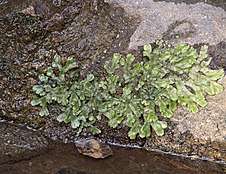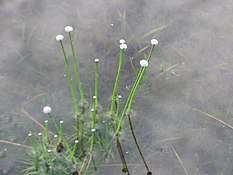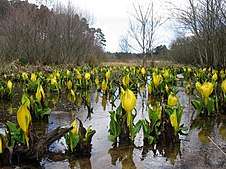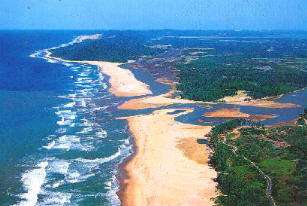Aquatic plant
Aquatic plants are plants that have adapted to living in aquatic environments (saltwater or freshwater). They are also referred to as hydrophytes or macrophytes to distinguish them from algae and other microphytes. A macrophyte is a plant that grows in or near water and is either emergent, submergent, or floating. In lakes and rivers macrophytes provide cover for fish, substrate for aquatic invertebrates, produce oxygen, and act as food for some fish and wildlife.[1]


Macrophytes are primary producers and are the basis of the food web for many organisms.[2] They have a significant effect on soil chemistry and light levels [3] as they slow down the flow of water and capture pollutants and trap sediments. Excess sediment will settle into the benthos aided by the reduction of flow rates caused by the presence of plant stems, leaves and roots. Some plants have the capability of absorbing pollutants into their tissue.[4][5] Seaweeds are multicellular marine algae and, although their ecological impact is similar to other larger water plants, they are not typically referred to as macrophytes.[5]
Aquatic plants require special adaptations for living submerged in water, or at the water's surface. The most common adaptation is the presence of lightweight internal packing cells, aerenchyma, but floating leaves and finely dissected leaves are also common.[6][7][8] Aquatic plants can only grow in water or in soil that is frequently saturated with water. They are therefore a common component of wetlands.[9] One of the largest aquatic plants in the world is the Amazon water lily; one of the smallest is the minute duckweed. Many small aquatic animals use plants such as duckweed for a home, or for protection from predators. Some other familiar examples of aquatic plants might include floating heart, water lily, lotus, and water hyacinth.
Distribution
The principal factor controlling the distribution of aquatic plants is the depth and duration of flooding. However, other factors may also control their distribution, abundance, and growth form, including nutrients, disturbance from waves, grazing, and salinity.[9] A few aquatic plants are able to survive in brackish, saline, and salt water.[6]
Evolution
Aquatic plants have adapted to live in either freshwater or saltwater. Aquatic vascular plants have originated on multiple occasions in different plant families;[6][10] they can be ferns or angiosperms (including both monocots and dicots). The only angiosperms capable of growing completely submerged in seawater are the seagrasses.[11] Examples are found in genera such as Thalassia and Zostera. An aquatic origin of angiosperms is supported by the evidence that several of the earliest known fossil angiosperms were aquatic. Aquatic plants are phylogenetically well dispersed across the angiosperms, with at least 50 independent origins, although they comprise less than 2% of the angiosperm species.[12] Archefructus represents one of the oldest, most complete angiosperm fossils which is around 125 million years old.[13] These plants require special adaptations for living submerged in water or floating at the surface.[13]
Although most aquatic plants can reproduce by flowering and setting seeds, many have also evolved to have extensive asexual reproduction by means of rhizomes, turions, and fragments in general.[7]
Photosynthesis in Aquatic Plants
Due to their underwater environment, aquatic plants have limited access to carbon and experience reduced light levels.[14] Aquatic plants have DBLs (diffusive boundary layers) that vary based on the leaves' thickness and density. DBLs are the main factor responsible for the lack of carbon fixation in aquatic plants.[14] Due to this reduced ability to collect nutrients, aquatic plants have adapted various mechanisms to maximize absorption.
In floating aquatic plants, the leaves have evolved to only have stomata on the top surface due to their non-submerged state.[15] Gas exchange primarily occurs through the top surface of the leaf due to the stomata’s position, and the stomata are in a permanently open state. Due to their aquatic surroundings, the plants are not at risk of losing water through the stomata and therefore face no risk of dehydration.[15] For carbon fixation, some aquatic angiosperms are able to uptake CO2 from bicarbonate in the water, a trait that does not exist in terrestrial plants.[14] Angiosperms that use HCO3- can maintain pH and keep CO2 levels satisfactory, even in basic environments with low carbon levels.[14]
Buoyancy Adaptations
Due to their environment, aquatic plants experience buoyancy which counteracts their weight.[16] Because of this, their cell covering are far more flexible and soft, due to a lack of pressure that terrestrial plants experience.[16] Green algae are also known to have extremely thin cell walls due to their aquatic surroundings, and research has shown that green algae is the closest ancestor to living terrestrial and aquatic plants.[17] Terrestrial plants have rigid cell walls meant for withstanding harsh weather, as well as keeping the plant upright as the plant resists gravity. Gravitropism, along with phototropism and hydrotropism, are traits believed to have evolved during the transition from an aquatic to terrestrial habitat.[18][19] Terrestrial plants no longer had unlimited access to water and had to evolve to search for nutrients in their new surroundings as well as develop cells with new sensory functions, such as statocytes.
Terrestrial Plants in Aquatic Environments
There have been multiple studies regarding the physiological changes that terrestrial plants undergo when submerged due to flooding. When submerged in an aquatic environment, new leaf growth from terrestrial plants has been found to have thinner leaves and thinner cell walls than the leaves on the plant that grew while above water, along with oxygen levels being higher in the portion of the plant grown underwater versus the sections that grew in their terrestrial environment.[20] This is considered a form of phenotypic plasticity as the plant, once submerged, experiences changes in morphology better suited to their new aquatic environment.[20] However, while some terrestrial plants may be able to adapt short-term to an aquatic habitat, there is no guarantee that the plant will be able to reproduce underwater, especially if the plant usually relies on terrestrial pollinators.
Classification of Macrophytes
Based on growth form, macrophytes can be characterised as:
- Emergent
- Submerged
- Rooted: rooted to the substrate
- Unrooted: free-floating in the water column
- Attached: attached to substrate but not by roots
- Floating-leaved
- Free-floating[21]
Emergent
An emergent plant is one which grows in water but pierces the surface so that it is partially in air. Collectively, such plants are emergent vegetation.
This habit may have developed because the leaves can photosynthesis more efficiently in air and competition from submerged plants but often, the main aerial feature is the flower and the related reproductive process. The emergent habit permits pollination by wind or by flying insects.[22]
There are many species of emergent plants, among them, the reed (Phragmites), Cyperus papyrus, Typha species, flowering rush and wild rice species. Some species, such as purple loosestrife, may grow in water as emergent plants but they are capable of flourishing in fens or simply in damp ground.[23]
Submerged
Submerged macrophytes completely grow under water with roots attached to the substrate (e.g. Myriophyllum spicatum) or without any root system (e.g. Ceratophyllum demersum). Helophytes are plants that grows in a marsh, partly submerged in water, so that it regrows from buds below the water surface.[24] Fringing stands of tall vegetation by water basins and rivers may include helophytes. Examples include stands of Equisetum fluviatile, Glyceria maxima, Hippuris vulgaris, Sagittaria, Carex, Schoenoplectus, Sparganium, Acorus, yellow flag (Iris pseudacorus), Typha and Phragmites australis.[24]
Floating-leaved
Floating-leaved macrophytes have root systems attached to the substrate or bottom of the body of water and with leaves that float on the water surface. Common floating leaved macrophytes are water lilies (family Nymphaeaceae), pondweeds (family Potamogetonaceae).[25]
Free-floating
Free-floating macrophytes are aquatic plants that are found suspended on water surface with their root not attached to substrate, sediment, or bottom of the water body. They are easily blown by air and provide breeding ground for mosquitoes. Example include Pistia spp commonly called water lettuce, water cabbage or Nile cabbage.[25]
Morphological classification
The many possible classifications of aquatic plants are based upon morphology.[6] One example has six groups as follows:[26]
- Amphiphytes: plants that are adapted to live either submerged or on land
- Elodeids: stem plants that complete their entire lifecycle submerged, or with only their flowers above the waterline
- Isoetids: rosette plants that complete their entire lifecycle submerged
- Helophytes: plants rooted in the bottom, but with leaves above the waterline
- Nymphaeids: plants rooted in the bottom, but with leaves floating on the water surface
- Pleuston: vascular plants that float freely in the water
Functions of macrophytes in aquatic system
Macrophytes perform many ecosystem functions in aquatic ecosystems and provide services to human society. One of the important functions performed by macrophyte is uptake of dissolve nutrients (N and P) from water.[3] Macrophytes are widely used in constructed wetlands around the world to remove excess N and P from polluted water.[27] Beside direct nutrient uptake, macrophytes indirectly influence nutrient cycling, especially N cycling through influencing the denitrifying bacterial functional groups that are inhabiting on roots and shoots of macrophytes.[28] Macrophytes promote the sedimentation of suspended solids by reducing the current velocities,[29] impede erosion by stabilising soil surfaces.[30] Macrophytes also provide spatial heterogeneity in otherwise unstructured water column. Habitat complexity provided by macrophytes like to increase the richness of taxonomy and density of both fish and invertebrates.[31]
Uses and importance to humans
Food crops

Some aquatic plants are used by humans as a food source. Examples include wild rice (Zizania), water caltrop (Trapa natans), Chinese water chestnut (Eleocharis dulcis), Indian lotus (Nelumbo nucifera), water spinach (Ipomoea aquatica), and watercress (Rorippa nasturtium-aquaticum).
Bioassessment
A decline in a macrophyte community may indicate water quality problems and changes in the ecological status of the water body. Such problems may be the result of excessive turbidity, herbicides, or salination. Conversely, overly high nutrient levels may create an overabundance of macrophytes, which may in turn interfere with lake processing.[1] Macrophyte levels are easy to sample, do not require laboratory analysis, and are easily used for calculating simple abundance metrics.[1]
Potential sources of therapeutic agents
Phytochemical and pharmacological researches suggest that freshwater macrophytes, such as Centella asiatica, Nelumbo nucifera, Nasturtium officinale, Ipomoea aquatica and Ludwigia adscendens, are promising sources of anticancer and antioxidative natural products.[32]
Hot water extracts of the stem and root of Ludwigia adscendens, as well as those of the fruit, leaf and stem of Monochoria hastata were found to have lipoxygenase inhibitory activity. Hot water extract prepared from the leaf of Ludwigia adscendens exhibits alpha-glucosidase inhibitory activity more potent than that of acarbose.[33]
See also
- Aquatic Botany (journal)
- Wetland – land area that is permanently or seasonally saturated with water
- Wetland indicator status
- List of freshwater aquarium plant species – Wikipedia list article
References
- "Macrophytes as Indicators of freshwater marshes in Florida" (PDF). Retrieved 2014-04-05.
- Chambers, Patricia A. (September 1987). "Light and Nutrients in the Control of Aquatic Plant Community Structure. II. In Situ Observations". The Journal of Ecology. 75 (3): 621–628. doi:10.2307/2260194. JSTOR 2260194.
- "Do macrophytes play a role in constructed treatment wetlands?". Water Science and Technology. 35 (5). 1997. doi:10.1016/s0273-1223(97)00047-4. ISSN 0273-1223.
- Cowardin, Lewis M.; Carter, Virginia; Golet, Francis C.; Laroe, Edward T. (2005-07-15), "Classification of Wetlands and Deepwater Habitats of the United States", in Lehr, Jay H.; Keeley, Jack (eds.), Water Encyclopedia, John Wiley & Sons, Inc., pp. sw2162, doi:10.1002/047147844x.sw2162, ISBN 9780471478447, archived from the original on 2019-12-21, retrieved 2019-11-16
- Krause-Jensen, Dorte; Sand-Jensen, Kaj (May 1998). "Light attenuation and photosynthesis of aquatic plant communities". Limnology and Oceanography. 43 (3): 396–407. Bibcode:1998LimOc..43..396K. doi:10.4319/lo.1998.43.3.0396. ISSN 0024-3590.
- Sculthorpe, C. D. 1967. The Biology of Aquatic Vascular Plants. Reprinted 1985 Edward Arnold, by London.
- Hutchinson, G. E. 1975. A Treatise on Limnology, Vol. 3, Limnological Botany. New York: John Wiley.
- Cook, C.D.K. (ed). 1974. Water Plants of the World. Dr W Junk Publishers, The Hague. ISBN 90-6193-024-3.
- Keddy, P.A. 2010. Wetland Ecology: Principles and Conservation (2nd edition). Cambridge University Press, Cambridge, UK. 497 p.
- Tomlinson, P. B. 1986. The Botany of Mangroves. Cambridge, UK: Cambridge University Press.
- "Alismatales". Angiosperm Phylogeny Website. Missouri Botanical Garden.
- Pennisi, Elizabeth (2018-06-01). "This saltwater trout evolved to live in freshwater—in just 100 years". Science. doi:10.1126/science.aau3582. ISSN 0036-8075.
- Mader, Sylvia S. (1998). Biology. WCB/McGraw-Hill. ISBN 0-697-34079-1. OCLC 37418228.
- Pedersen, Ole; Colmer, Timothy David; Sand-Jensen, Kaj (2013). "Underwater Photosynthesis of Submerged Plants – Recent Advances and Methods". Frontiers in Plant Science. 4. doi:10.3389/fpls.2013.00140. ISSN 1664-462X.
- Shtein, Ilana; Popper, Zoë A.; Harpaz-Saad, Smadar (2017-07-03). "Permanently open stomata of aquatic angiosperms display modified cellulose crystallinity patterns". Plant Signaling & Behavior. 12 (7): e1339858. doi:10.1080/15592324.2017.1339858. ISSN 1559-2324. PMC 5586356. PMID 28718691.
- Okuda, Kazuo (2002-08-01). "Structure and phylogeny of cell coverings". Journal of Plant Research. 115 (4): 283–288. doi:10.1007/s10265-002-0034-x. ISSN 1618-0860.
- Sarkar, Purbasha; Bosneaga, Elena; Auer, Manfred (2009-09-01). "Plant cell walls throughout evolution: towards a molecular understanding of their design principles". Journal of Experimental Botany. 60 (13): 3615–3635. doi:10.1093/jxb/erp245. ISSN 0022-0957.
- Vries, Jan de; Archibald, John M. (2018). "Plant evolution: landmarks on the path to terrestrial life". New Phytologist. 217 (4): 1428–1434. doi:10.1111/nph.14975. ISSN 1469-8137.
- Najrana, Tanbir; Sanchez-Esteban, Juan (2016-12-26). "Mechanotransduction as an Adaptation to Gravity". Frontiers in Pediatrics. 4. doi:10.3389/fped.2016.00140. ISSN 2296-2360. PMC 5183626. PMID 28083527.
- Mommer, Liesje; Wolters‐Arts, Mieke; Andersen, Charlotte; Visser, Eric J. W.; Pedersen, Ole (2007). "Submergence-induced leaf acclimation in terrestrial species varying in flooding tolerance". New Phytologist. 176 (2): 337–345. doi:10.1111/j.1469-8137.2007.02166.x. ISSN 1469-8137.
- van der Valk, Arnold (2006). The Biology of Freshwater Wetlands. New York: Oxford University Press. ISBN 9780199608942.
- Vymazal, Jan (December 2013). "Emergent plants used in free water surface constructed wetlands: A review". Ecological Engineering. 61: 582–592. doi:10.1016/j.ecoleng.2013.06.023. ISSN 0925-8574.
- Swearingen, Jil M. (7 July 2009). "PCA Alien Plant Working Group - Purple Loosestrife (Lythrum salicaria)". National Park Service. Retrieved 24 September 2011.
- Beentje, Henk; Hickey, Michael; King, Clive (2001). "The Cambridge Illustrated Glossary of Botanical Terms". Kew Bulletin. 56 (2): 505. doi:10.2307/4110976. ISSN 0075-5974. JSTOR 4110976. S2CID 86620932.
- Bornette, Gudrun; Amoros, Claude; Lamouroux, Nicolas (March 1998). "Aquatic plant diversity in riverine wetlands: the role of connectivity". Freshwater Biology. 39 (2): 267–283. doi:10.1046/j.1365-2427.1998.00273.x. ISSN 0046-5070.
- Westlake, D.F., Kvĕt, J. and Szczepański, A. 1998. The Production Ecology of Wetlands. Cambridge: Cambridge University Press.
- Vymazal, Jan (2013). "Emergent plants used in free water surface constructed wetlands: A review". Ecological Engineering. 61: 582–592. doi:10.1016/j.ecoleng.2013.06.023.
- Hallin, Sara; Hellman, Maria; Choudhury, Maidul I.; Ecke, Frauke (2015). "Relative importance of plant uptake and plant associated denitrification for removal of nitrogen from mine drainage in sub-arctic wetlands". Water Research. 85: 377–383. doi:10.1016/j.watres.2015.08.060. PMID 26360231.
- Zhu, M.Y., Zhu, G.W., Nurminen, L., Wu, T.F., Deng, J.M., Zhang, Y.L., Qin, B.Q. & Ventela, A.M. (2015) The Influence of Macrophytes on Sediment Resuspension and the Effect of Associated Nutrients in a Shallow and Large Lake (Lake Taihu, China). PLoS ONE, 10.
- Horppila, Jukka; Kaitaranta, Joni; Joensuu, Laura; Nurminen, Leena (2013). "Influence of emergent macrophyte (Phragmites australis) density on water turbulence and erosion of organic-rich sediment". Journal of Hydrodynamics. 25 (2): 288–293. Bibcode:2013JHyDy..25..288H. doi:10.1016/S1001-6058(13)60365-0.
- Thomaz, Sidinei M.; Dibble, Eric D.; Evangelista, Luiz R.; Higuti, Janet; Bini, Luis M. (2007). "Influence of aquatic macrophyte habitat complexity on invertebrate abundance and richness in tropical lagoons". Freshwater Biology: 071116231725007––. doi:10.1111/j.1365-2427.2007.01898.x.
- Chai TT, Ooh KF, Quah Y, Wong FC (2015) Edible freshwater macrophytes: a source of anticancer and antioxidative natural products—a mini-review. Phytochemistry Reviews 14(3): 443–457
- Ooh KF, Ong HC, Wong FC, Sit NW, Chai TT (2014) High performance liquid chromatography profiling of health-promoting phytochemicals and evaluation of antioxidant, anti-lipoxygenase, iron chelating and anti-glucosidase activities of wetland macrophytes. Pharmacognosy Magazine 10(39): 443-455.
External links
| Wikimedia Commons has media related to Aquatic plants. |





.jpg)

